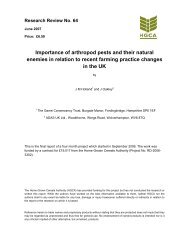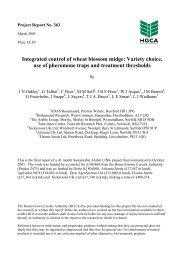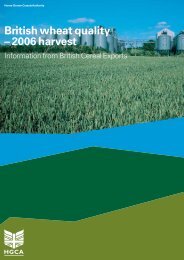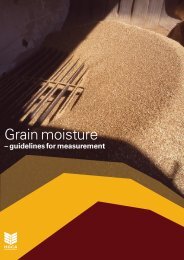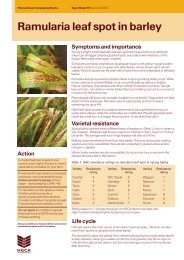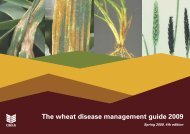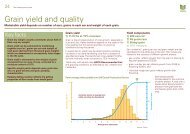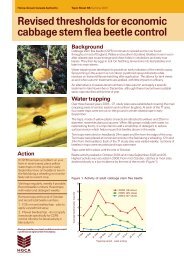BIOETHANOL GREENHOUSE GAS CALCULATOR - HGCA
BIOETHANOL GREENHOUSE GAS CALCULATOR - HGCA
BIOETHANOL GREENHOUSE GAS CALCULATOR - HGCA
Create successful ePaper yourself
Turn your PDF publications into a flip-book with our unique Google optimized e-Paper software.
3recovery (LCVP report; Rickeard et al, 2004). This model assumes thatthe straw is ploughed back in and is therefore awarded a nitrogen creditreducing the N-fertiliser requirement from 253kgN per ha to 185kgN/ha.The calculator described here, provides farmers with a simple tool to assess theimpact of changes in management and inputs on the lifecycle GHG balance forethanol production from wheat in the UK. It reports in both tabular and graphicalformats, the impact of changes in inputs (e.g. nitrogen fertiliser rates) on the finalGHG balance for ethanol for a selected conversion chain. As a result farmers, biofuelproducers and policy makers can assess the value of investing in new more energyefficient equipment or altering the level of inputs to strike the best yield : inputbalance for an entire production chain.1.2 Why now?That it is not possible to calculate a credible single generic GHG (or carbon) factor forthe net (LCA) emissions resulting from the use of a biofuels at the national level hasprofound implications for the development of the sector and the calculation ofincentives or tax breaks that Government can or should award. The combination ofthe high oil price, the EU Biofuels Directive (EU, 2003) and the imminentannouncement of the UK Renewable Transport Fuels Obligation are powerful driversfor the increased production and utilisation of biofuels in the UK.The existing mechanisms to discourage GHG emissions, such as the UK EmissionsTrading Scheme, operate at the national boundary and are therefore not sufficientlycapable of differentiating between the emissions resulting from the different sectors.In addition, the Renewables Obligation (RO) for the electricity sector, assumes strictcarbon-neutrality for the biomass feedstocks consumed, despite widely divergentorigins and compositions and there is currently no mechanism for assessing the GHGintensity of renewable transport fuel options.The UK government has made a powerful yet challenging commitment to thereduction of national GHG emissions within the Kyoto framework and beyond whichleaves planners with no option than to address transport sector emissions togetherwith the other sectors. Yet in the short term, the only proven viable alternatives topetrol and diesel are biofuels (bioethanol and biodiesel). The development of a UKassurance scheme for biofuel production will provide a transparent framework forevaluating the actual GHG emissions from alternative routes to producing and usingrenewable transport fuels (see for example Woods & Bauen, 2003). It is therefore,critical that biofuel production (and use) is optimised to maximise the GHG benefitsthat can arise from substituting the relevant fossil fuels.Should government policy incentivise energy use on the basis of quantified GHGemissions, producers and suppliers risk having locked themselves into inefficientsupply pathways (including sunk investments in infrastructure) and thus becominguncompetitive unless they maximise GHG performance now. The calculator has beendeveloped to allow these calculations to take place using an agreed and transparentevidence base.



